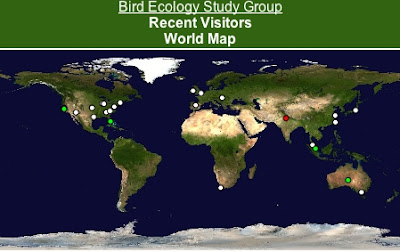The Bird Ecology Study Group was formed in September 2005 to encourage local birders to observe birds rather than to just look at them. This weblog, highlighting various aspects of bird behaviour, was started with the aim of making such information available to everyone and anyone.
Postings initially came from a few supporters. Within a few months longstanding birders as well as newbies contributed their observations. Contributors included members of the Nature Society (Singapore) as well as non-members. Photographers were more than generous in allowing us to make use of their images, many being accidental students of bird behaviour.
The blog has so far proved successful beyond our wildest dream. We started off with one to two postings a week and getting around 30 hits a day. By the end of 2005 we had about 4,000 hits or an average of 1,000 a month. By 2006 birders around the region and the world became more aware of the blog (top). The chart above shows the global share of visitors accessing the blog.
Currently, we are experiencing up to 200 and above hits per day. Our postings have been increased to 5-7 a week. The total number of hits for 2006 is in excess of 35,000. The chart below shows the monthly hits or visits and the number of pages viewed for the year 2006.
So far we have posted a total of 285 articles on bird behaviour – from nesting observations to interspecific relationship; and from feather maintenance to feeding strategies. Birders are now well aware that birds do get drunk, they use ants to remove parasites found on their feathers (anting), that many birds other than raptors cast pellets of indigestible matters from their food, and many more.
How has BESGroup influenced birders in general, you may ask? For starters, e-loop discussions nowadays do not always provide list after list of bird species sighted. On and off you may find these lists peppered with snippets of bird behaviour.
However, the best example of our success is the latest posting in the widlbird e-loop that gives an interesting account of the Oriental Honey-buzzard raiding a bees’ hive at Mount Faber (below). Although the loop discourages images, especially “pretty” images, Alan Owyong has thoughtfully directed viewers to a separate web album where viewers can see the exciting images.
Thank you Alan for taking this first step in sharing this sighting with other birders. BESGroup is gratified to know that there are more birders willing to share. After all, isn’t this the time of the year for sharing?
BESGroup wishes all out supporters (contributors, photographers, viewers, etc.) an interesting and successful birding in this new year. Thank you all.










